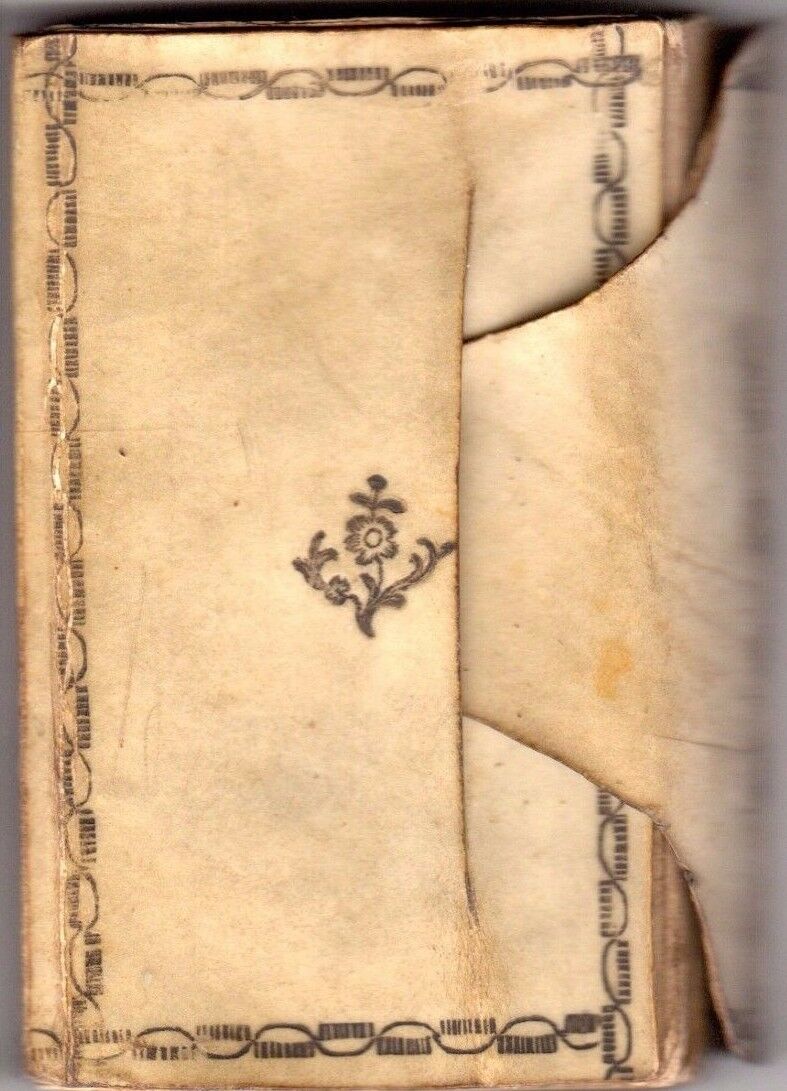-40%
Genealogical Calendar (1787) with approval of Royal Academy of Sciences, Berlin
$ 1056
- Description
- Size Guide
Description
TheGenealogischer Calender auf das Yahr 1787
mit Kupferningezierets und
mit Genehmigung der Königlichen Academie der Wissenschaften zu Berlin herausgegeben
(
Genealogical Calendar On the year 1787 with copper engravings and with the approval of the Royal Academy of Sciences at Berlin
)
was published
in Berlin
for the year 1787.
The book, which measures approximately 2 ½ x 4 inches, contains over 200
string-bound
pages and is bound in a stamped vellum cover that wraps around the whole book, with a “flap/slot” seal in the front. The book is written in German.
Some of the features of this
Genealogical Calendar
are:
The initial pages contain the typical data for the months of the year usually found in almanacs. The section is enhanced, however, by 12 engraved plates by Daniel Chadowieki, that appear – one for each month. The plates bear no relationship to the data shown for the month, but instead represents scenes from the play
Die J
ä
ger
by the German actor and playwright August Iffland.
A
n eight page explanation of
the
engraving
s
follows the almanac-like section.
A
major section of the book is devoted to
Genealogie der regierenden hohen haupter und anderer furstlichen personen in
E
uropa (Genealogy of the reigning chiefs and other princely persons in
E
urope).
There is a large section of tables showing distances between European locations and major German cities
There are many other sections providing data that may be of interest to readers. Knowledge of the German language would be very helpful in assessing the overall contents of the book.
The
book’s
condition
recognizes
that the vellum cover has lost some of its flexibility and shows signs of wear on the inside surfaces
and the rear portion is detached from the text
, the Title page is torn and missing a piece,
and
the first two pages following the title page are missing,
The pages of the book are strongly bound by string. The pages themselves are gilt edged, with text that is clear and easily read.
The overall condition of the book, considering its age, is good to very good.
The pictures above show:
The front cover of the book
The Title page of the book
One month of the Calendar, showing one of the Chadowieki engravings
The first page of the geneology
One page of the table of distances between cities
Daniel Niklaus Chodowiecki
(16 October 1726 – 7 February 1801) was a
Polish
—
and later
German
—
painter and
printmaker
with Huguenot ancestry, who is most famous as an
etcher.
He spent most of his life in
Berlin,
and became the director of the
Berlin Academy of Art.
He had found his true calling and became the most famous German graphic artist of his time. His works includes several thousand
etchings,
usually rather small, and many drawings and paintings. His book illustrations embrace almost all the great classics. His prints represent in great detail the life of the bourgeoisie during the
Zopfstil
period, a time between
Rococo and Classicism. [Wikipedia]
August Wilhelm Iffland
(19 April 1759 – 22 September 1814) was a German actor and
dramatic
author.
The form of play in which Iffland was most at home, both as an actor and playwright, was the domestic drama, the sentimental play of everyday life. His works show little imagination, but they display a thorough mastery of the technical necessities of the stage, and a remarkable power of devising effective situations. His best characters are simple and natural, fond of domestic life, but too much given the utterance of commonplace sentimentality. His best-known plays are
Die Jäger
,
Dienstpflicht
,
Die Advokaten
,
Die Mündel
and
Die Hagstolzen
.
[Wikipedia]













